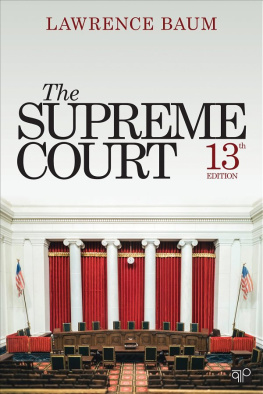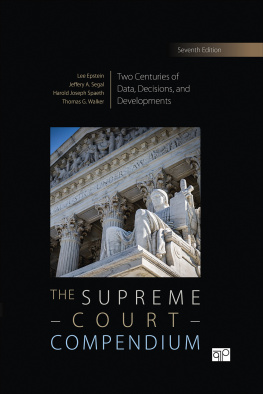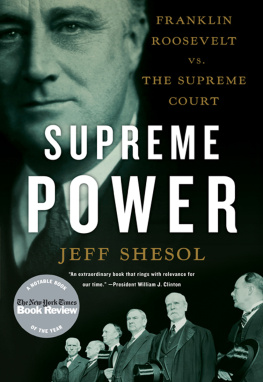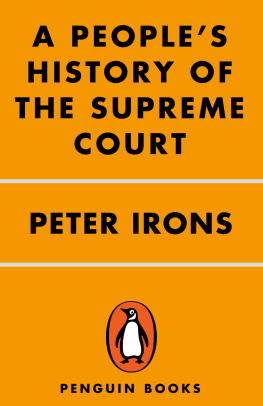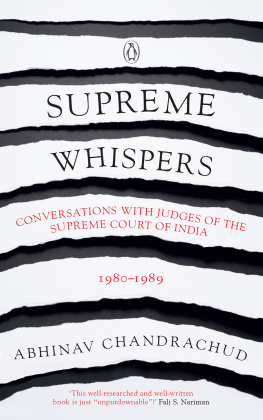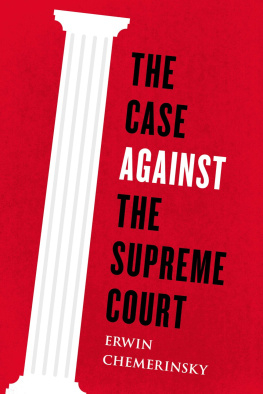Lawrence Baum - The Supreme Court. Thirteenth Edition
Here you can read online Lawrence Baum - The Supreme Court. Thirteenth Edition full text of the book (entire story) in english for free. Download pdf and epub, get meaning, cover and reviews about this ebook. year: 2018, genre: Science / Politics. Description of the work, (preface) as well as reviews are available. Best literature library LitArk.com created for fans of good reading and offers a wide selection of genres:
Romance novel
Science fiction
Adventure
Detective
Science
History
Home and family
Prose
Art
Politics
Computer
Non-fiction
Religion
Business
Children
Humor
Choose a favorite category and find really read worthwhile books. Enjoy immersion in the world of imagination, feel the emotions of the characters or learn something new for yourself, make an fascinating discovery.
- Book:The Supreme Court. Thirteenth Edition
- Author:
- Genre:
- Year:2018
- Rating:5 / 5
- Favourites:Add to favourites
- Your mark:
- 100
- 1
- 2
- 3
- 4
- 5
The Supreme Court. Thirteenth Edition: summary, description and annotation
We offer to read an annotation, description, summary or preface (depends on what the author of the book "The Supreme Court. Thirteenth Edition" wrote himself). If you haven't found the necessary information about the book — write in the comments, we will try to find it.
The Supreme Court. Thirteenth Edition — read online for free the complete book (whole text) full work
Below is the text of the book, divided by pages. System saving the place of the last page read, allows you to conveniently read the book "The Supreme Court. Thirteenth Edition" online for free, without having to search again every time where you left off. Put a bookmark, and you can go to the page where you finished reading at any time.
Font size:
Interval:
Bookmark:
Thirteenth Edition
To my students
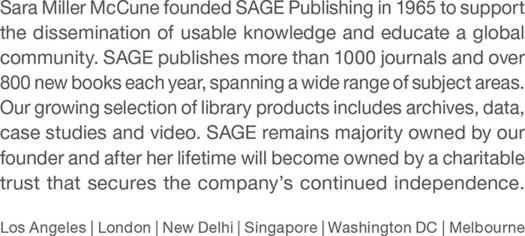
Thirteenth Edition
- Lawrence Baum
- Ohio State University


FOR INFORMATION:
CQ Press
An Imprint of SAGE Publications, Inc.
2455 Teller Road
Thousand Oaks, California 91320
E-mail: order@sagepub.com
SAGE Publications Ltd.
1 Olivers Yard
55 City Road
London EC1Y 1SP
United Kingdom
SAGE Publications India Pvt. Ltd.
B 1/I 1 Mohan Cooperative Industrial Area
Mathura Road, New Delhi 110 044
India
SAGE Publications Asia-Pacific Pte. Ltd.
3 Church Street
#10-04 Samsung Hub
Singapore 049483
Copyright 2019 by CQ Press, an Imprint of SAGE Publications, Inc. CQ Press is a registered trademark of Congressional Quarterly Inc.
All rights reserved. No part of this book may be reproduced or utilized in any form or by any means, electronic or mechanical, including photocopying, recording, or by any information storage and retrieval system, without permission in writing from the publisher.
Printed in the United States of America
Library of Congress Cataloging-in-Publication Data
Names: Baum, Lawrence, author.
Title: The Supreme Court / Lawrence Baum, Ohio State University.
Description: Thirteenth edition. | Washington, D.C. : CQ Press, a division of Sage, [2019] | Includes bibliographical references and index.
Identifiers: LCCN 2018016906 | ISBN 9781544327389 (pbk. : alk. paper)
Subjects: LCSH: United States. Supreme Court. | Constitutional lawUnited States. | Courts of last resortUnited States. | Judicial reviewUnited States.
Classification: LCC KF8742 .B35 2019 | DDC 347.73/26dc23 LC record available at https://lccn.loc.gov/2018016906
This book is printed on acid-free paper.

Acquisitions Editor: Monica Eckman
Editorial Assistant: Sam Rosenberg
Production Editor: Andrew Olson
Copy Editor: Diane DiMura
Typesetter: C&M Digitals (P) Ltd.
Proofreader: Talia Greenberg
Cover Designer: Glenn Vogel
Marketing Manager: Erica DeLuca
Throughout its history, the Supreme Court has attracted attention from people who care about government and politics. That attention has grown in recent years, in part because of the impact of partisan and ideological polarization on the Court. Indeed, the fierce battle over appointment of a successor to Justice Antonin Scalia after his death early in 2016 became a major issue in the presidential election that year.
Once Neil Gorsuch was appointed in 2017 to succeed Scalia, the key question for observers of the Court was the directions that the Court with its new justice would take in its decisions. That question brought additional interest in 2018 to the annual ritual of waiting for the major decisions that the Court issues at the end of its annual term in June.
That interest was fully justified. In the last two weeks of the term, the Court reached decisions on several major issues, including the collection of sales taxes on Internet purchases, government tracking of peoples locations through records generated by cell phones, and an order by President Trump that restricted travel to the U.S. by citizens of certain countries. Justice Gorsuch was part of a 54 majority in some key decisions that divided the justices along ideological and party lines.
The biggest news of all came shortly after the Court issued its final decisions, when Justice Anthony Kennedy announced that he would retire at the end of July. Because Kennedy had been the most moderate of the Courts five conservative justices, his impending retirement gave President Trump an opportunity to establish a more clear-cut conservative majority on the Court. Two weeks later, the president announced that his nominee for Kennedys seat was Brett Kavanaugh, a federal court of appeals judge who was generally thought to be strongly conservative in his views about legal issues.
Because of the high stakes of this nomination for politics and policy, it triggered a large-scale battle over Senate confirmation of Judge Kavanaugh. Although the confirmation vote had not yet occurred when this book was completed, the existence of a slim Republican majority in the Senate made it very likely that Kavanaugh would be confirmed. And even if Kavanaugh was defeated, only an unexpected Democratic majority in the Senate after the 2018 elections could prevent the president from putting another strong conservative on the Court in Kavanaughs place. In turn, a more conservative Court was likely to shift the legal rules on some issues that affect the lives of many people and the collective life of the nation.
The Courts importance makes it understandable that it receives so much attention. But that attention is not fully matched by understanding of the Court. It is a complicated institution, one that is more difficult to comprehend than the other branches of government. As a result, people with great interest in American government and politicseven some who are experts in most aspects of that fieldoften have only limited knowledge of the Court.
I have written this book to provide a better understanding of the Supreme Court. The book is intended to serve as a short but comprehensive guide to the Court, both for readers who already know much about the Court and for those who have a more limited sense of it. I discuss how the Court functions, the work that it does, and the effects of its rulings on the lives of people in the United States. And I probe explanations of the decisions that the Court and its justices make, of actions by other people and groups that affect the Court, and of the Courts impact on government and society.
The book discusses the Courts history in order to provide needed perspective, but its primary concern is the current era. In discussing topics such as the selection of justices and the substance of the Courts decisions, I give particular attention to developments that shape todays Court. Some important developments are related to the growth in polarization. One effect of that polarization is the increasing unwillingness of senators to support confirmation of nominees to the Court who are appointed by a president from the opposing party. Another effect is the division of the Court since 2010 along ideological lines that coincide with party lines, a division that seems natural but one that has no parallel in the Courts prior history.
The books first chapter introduces the Supreme Court. In this chapter, I discuss the Courts role in general terms, examine its place in the judicial system, analyze the Court as an institution, and present a brief summary of its history.
Each of the other chapters deals with an important aspect of the Court. discusses how cases reach the Court through the actions of parties to cases, the lawyers who represent them, interest groups, and the federal government in its special role. The chapter then considers how and why the Court selects the small number of cases that it will fully consider and decide.
Font size:
Interval:
Bookmark:
Similar books «The Supreme Court. Thirteenth Edition»
Look at similar books to The Supreme Court. Thirteenth Edition. We have selected literature similar in name and meaning in the hope of providing readers with more options to find new, interesting, not yet read works.
Discussion, reviews of the book The Supreme Court. Thirteenth Edition and just readers' own opinions. Leave your comments, write what you think about the work, its meaning or the main characters. Specify what exactly you liked and what you didn't like, and why you think so.

